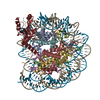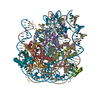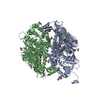[English] 日本語
 Yorodumi
Yorodumi- EMDB-31020: Structural insight into BRCA1-BARD1 complex recruitment to damage... -
+ Open data
Open data
- Basic information
Basic information
| Entry | Database: EMDB / ID: EMD-31020 | |||||||||||||||||||||||||||
|---|---|---|---|---|---|---|---|---|---|---|---|---|---|---|---|---|---|---|---|---|---|---|---|---|---|---|---|---|
| Title | Structural insight into BRCA1-BARD1 complex recruitment to damaged chromatin | |||||||||||||||||||||||||||
 Map data Map data | ||||||||||||||||||||||||||||
 Sample Sample |
| |||||||||||||||||||||||||||
 Keywords Keywords | BRCA1 / nucleosome / DNA damage / chromatin / BARD1 / NUCLEAR PROTEIN | |||||||||||||||||||||||||||
| Function / homology |  Function and homology information Function and homology informationnegative regulation of mRNA 3'-end processing / Defective DNA double strand break response due to BRCA1 loss of function / Defective DNA double strand break response due to BARD1 loss of function / BRCA1-BARD1 complex / BRCA1-C complex / BRCA1-B complex / BRCA1-A complex / nuclear ubiquitin ligase complex / DNA strand resection involved in replication fork processing / homologous recombination ...negative regulation of mRNA 3'-end processing / Defective DNA double strand break response due to BRCA1 loss of function / Defective DNA double strand break response due to BARD1 loss of function / BRCA1-BARD1 complex / BRCA1-C complex / BRCA1-B complex / BRCA1-A complex / nuclear ubiquitin ligase complex / DNA strand resection involved in replication fork processing / homologous recombination / tissue homeostasis / protein K6-linked ubiquitination / regulation of DNA damage checkpoint / regulation of phosphorylation / Impaired BRCA2 binding to PALB2 / mitotic G2/M transition checkpoint / negative regulation of protein export from nucleus / Defective homologous recombination repair (HRR) due to BRCA1 loss of function / Defective HDR through Homologous Recombination Repair (HRR) due to PALB2 loss of BRCA1 binding function / Defective HDR through Homologous Recombination Repair (HRR) due to PALB2 loss of BRCA2/RAD51/RAD51C binding function / Homologous DNA Pairing and Strand Exchange / Resolution of D-loop Structures through Synthesis-Dependent Strand Annealing (SDSA) / Resolution of D-loop Structures through Holliday Junction Intermediates / HDR through Single Strand Annealing (SSA) / Impaired BRCA2 binding to RAD51 / Presynaptic phase of homologous DNA pairing and strand exchange / negative regulation of cell cycle / regulation of DNA repair / ubiquitin ligase complex / cellular response to ionizing radiation / Nonhomologous End-Joining (NHEJ) / RING-type E3 ubiquitin transferase / HDR through Homologous Recombination (HRR) / G2/M DNA damage checkpoint / Metalloprotease DUBs / kinase binding / cytoplasmic ribonucleoprotein granule / positive regulation of protein catabolic process / structural constituent of chromatin / ubiquitin-protein transferase activity / UCH proteinases / nucleosome / nucleosome assembly / Recruitment and ATM-mediated phosphorylation of repair and signaling proteins at DNA double strand breaks / Processing of DNA double-strand break ends / Regulation of TP53 Activity through Phosphorylation / regulation of cell cycle / protein ubiquitination / nuclear speck / positive regulation of apoptotic process / protein heterodimerization activity / DNA repair / DNA damage response / negative regulation of apoptotic process / protein homodimerization activity / DNA binding / RNA binding / nucleoplasm / nucleus / metal ion binding / cytoplasm Similarity search - Function | |||||||||||||||||||||||||||
| Biological species |  Homo sapiens (human) / Homo sapiens (human) / | |||||||||||||||||||||||||||
| Method | single particle reconstruction / cryo EM / Resolution: 3.1 Å | |||||||||||||||||||||||||||
 Authors Authors | Dai Y / Dai L | |||||||||||||||||||||||||||
| Funding support |  China, 8 items China, 8 items
| |||||||||||||||||||||||||||
 Citation Citation |  Journal: Mol Cell / Year: 2021 Journal: Mol Cell / Year: 2021Title: Structural insight into BRCA1-BARD1 complex recruitment to damaged chromatin. Authors: Linchang Dai / Yaxin Dai / Jinhua Han / Yan Huang / Longge Wang / Jun Huang / Zheng Zhou /  Abstract: The BRCA1-BARD1 complex directs the DNA double-strand break (DSB) repair pathway choice to error-free homologous recombination (HR) during the S-G2 stages. Targeting BRCA1-BARD1 to DSB-proximal sites ...The BRCA1-BARD1 complex directs the DNA double-strand break (DSB) repair pathway choice to error-free homologous recombination (HR) during the S-G2 stages. Targeting BRCA1-BARD1 to DSB-proximal sites requires BARD1-mediated nucleosome interaction and histone mark recognition. Here, we report the cryo-EM structure of BARD1 bound to a ubiquitinated nucleosome core particle (NCP) at 3.1 Å resolution and illustrate how BARD1 simultaneously recognizes the DNA damage-induced mark H2AK15ub and DNA replication-associated mark H4K20me0 on the nucleosome. In vitro and in vivo analyses reveal that the BARD1-NCP complex is stabilized by BARD1-nucleosome interaction, BARD1-ubiquitin interaction, and BARD1 ARD domain-BARD1 BRCT domain interaction, and abrogating these interactions is detrimental to HR activity. We further identify multiple disease-causing BARD1 mutations that disrupt BARD1-NCP interactions and hence impair HR. Together, this study elucidates the mechanism of BRCA1-BARD1 complex recruitment and retention by DSB-flanking nucleosomes and sheds important light on cancer therapeutic avenues. | |||||||||||||||||||||||||||
| History |
|
- Structure visualization
Structure visualization
| Movie |
 Movie viewer Movie viewer |
|---|---|
| Structure viewer | EM map:  SurfView SurfView Molmil Molmil Jmol/JSmol Jmol/JSmol |
| Supplemental images |
- Downloads & links
Downloads & links
-EMDB archive
| Map data |  emd_31020.map.gz emd_31020.map.gz | 59.7 MB |  EMDB map data format EMDB map data format | |
|---|---|---|---|---|
| Header (meta data) |  emd-31020-v30.xml emd-31020-v30.xml emd-31020.xml emd-31020.xml | 21 KB 21 KB | Display Display |  EMDB header EMDB header |
| Images |  emd_31020.png emd_31020.png | 47.9 KB | ||
| Filedesc metadata |  emd-31020.cif.gz emd-31020.cif.gz | 6.2 KB | ||
| Archive directory |  http://ftp.pdbj.org/pub/emdb/structures/EMD-31020 http://ftp.pdbj.org/pub/emdb/structures/EMD-31020 ftp://ftp.pdbj.org/pub/emdb/structures/EMD-31020 ftp://ftp.pdbj.org/pub/emdb/structures/EMD-31020 | HTTPS FTP |
-Validation report
| Summary document |  emd_31020_validation.pdf.gz emd_31020_validation.pdf.gz | 502.3 KB | Display |  EMDB validaton report EMDB validaton report |
|---|---|---|---|---|
| Full document |  emd_31020_full_validation.pdf.gz emd_31020_full_validation.pdf.gz | 501.8 KB | Display | |
| Data in XML |  emd_31020_validation.xml.gz emd_31020_validation.xml.gz | 5.4 KB | Display | |
| Data in CIF |  emd_31020_validation.cif.gz emd_31020_validation.cif.gz | 6.3 KB | Display | |
| Arichive directory |  https://ftp.pdbj.org/pub/emdb/validation_reports/EMD-31020 https://ftp.pdbj.org/pub/emdb/validation_reports/EMD-31020 ftp://ftp.pdbj.org/pub/emdb/validation_reports/EMD-31020 ftp://ftp.pdbj.org/pub/emdb/validation_reports/EMD-31020 | HTTPS FTP |
-Related structure data
| Related structure data |  7e8iMC M: atomic model generated by this map C: citing same article ( |
|---|---|
| Similar structure data |
- Links
Links
| EMDB pages |  EMDB (EBI/PDBe) / EMDB (EBI/PDBe) /  EMDataResource EMDataResource |
|---|---|
| Related items in Molecule of the Month |
- Map
Map
| File |  Download / File: emd_31020.map.gz / Format: CCP4 / Size: 64 MB / Type: IMAGE STORED AS FLOATING POINT NUMBER (4 BYTES) Download / File: emd_31020.map.gz / Format: CCP4 / Size: 64 MB / Type: IMAGE STORED AS FLOATING POINT NUMBER (4 BYTES) | ||||||||||||||||||||||||||||||||||||||||||||||||||||||||||||||||||||
|---|---|---|---|---|---|---|---|---|---|---|---|---|---|---|---|---|---|---|---|---|---|---|---|---|---|---|---|---|---|---|---|---|---|---|---|---|---|---|---|---|---|---|---|---|---|---|---|---|---|---|---|---|---|---|---|---|---|---|---|---|---|---|---|---|---|---|---|---|---|
| Voxel size | X=Y=Z: 1 Å | ||||||||||||||||||||||||||||||||||||||||||||||||||||||||||||||||||||
| Density |
| ||||||||||||||||||||||||||||||||||||||||||||||||||||||||||||||||||||
| Symmetry | Space group: 1 | ||||||||||||||||||||||||||||||||||||||||||||||||||||||||||||||||||||
| Details | EMDB XML:
CCP4 map header:
| ||||||||||||||||||||||||||||||||||||||||||||||||||||||||||||||||||||
-Supplemental data
- Sample components
Sample components
+Entire : BARD1-NCP-Ubiquitin complex
+Supramolecule #1: BARD1-NCP-Ubiquitin complex
+Supramolecule #2: DNA
+Supramolecule #3: Histone
+Supramolecule #4: BARD1-Ubiquitin
+Macromolecule #1: DNA (145-MER)
+Macromolecule #2: DNA (145-MER)
+Macromolecule #3: Histone H3
+Macromolecule #4: Histone H4
+Macromolecule #5: Histone H2A
+Macromolecule #6: Histone H2B 1.1
+Macromolecule #7: BRCA1-associated RING domain protein 1
+Macromolecule #8: Polyubiquitin-B
-Experimental details
-Structure determination
| Method | cryo EM |
|---|---|
 Processing Processing | single particle reconstruction |
| Aggregation state | particle |
- Sample preparation
Sample preparation
| Buffer | pH: 7.5 |
|---|---|
| Vitrification | Cryogen name: ETHANE |
- Electron microscopy
Electron microscopy
| Microscope | FEI TALOS ARCTICA |
|---|---|
| Image recording | Film or detector model: GATAN K2 SUMMIT (4k x 4k) / Average electron dose: 50.0 e/Å2 |
| Electron beam | Acceleration voltage: 200 kV / Electron source:  FIELD EMISSION GUN FIELD EMISSION GUN |
| Electron optics | Illumination mode: FLOOD BEAM / Imaging mode: BRIGHT FIELD |
| Experimental equipment |  Model: Talos Arctica / Image courtesy: FEI Company |
- Image processing
Image processing
| Startup model | Type of model: PDB ENTRY |
|---|---|
| Final reconstruction | Resolution.type: BY AUTHOR / Resolution: 3.1 Å / Resolution method: FSC 0.143 CUT-OFF / Number images used: 168313 |
| Initial angle assignment | Type: MAXIMUM LIKELIHOOD |
| Final angle assignment | Type: MAXIMUM LIKELIHOOD |
 Movie
Movie Controller
Controller





















